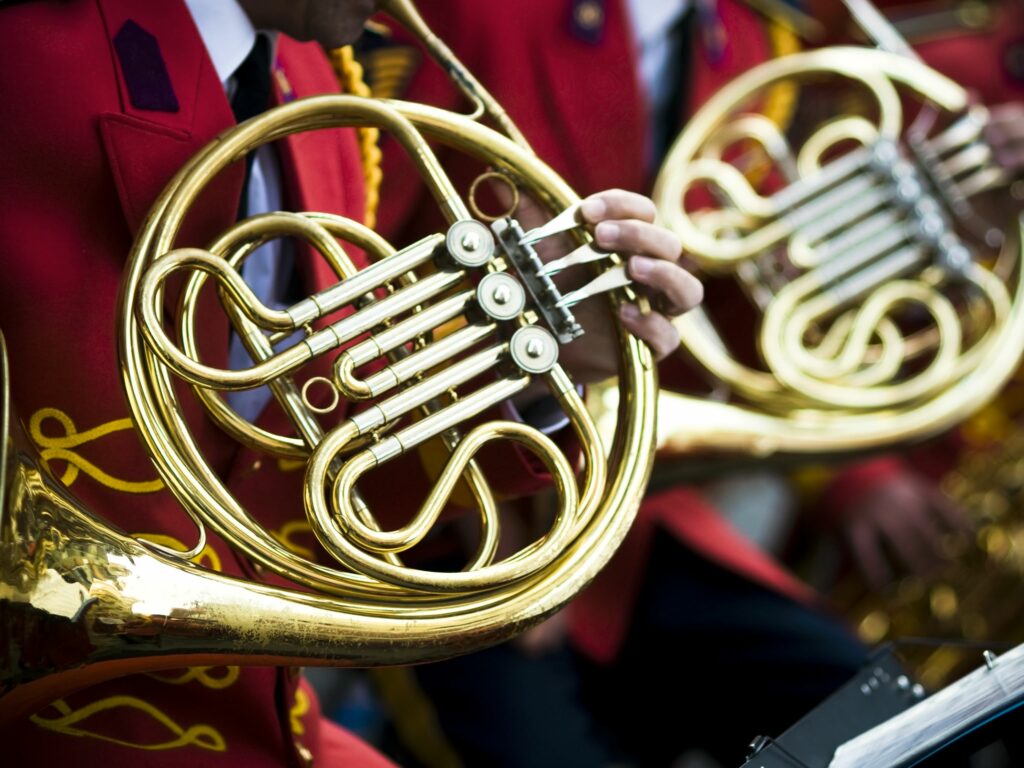- Famous Trombone Players Guide - September 5, 2022
- How to Find the Best Triple French Horns - May 30, 2022
- Best Bach Trumpet Options We Truly Stand By - May 27, 2022
Are you looking to get hold of a new double french horn? Or just doing some research into what they are and how to find the best one? Then, you’ve come to the right place! Here at brassnwind.com, we’ve compiled some advice about choosing a quality double horn regardless of your standard or budget.
Read on to find out what a double horn is, how it works, and how to get a good one!
What is a Double Horn?
French horns are incredibly old instruments, and you can actually trace their origins back to biblical times (although those instruments are utterly unrecognizable from contemporary horns). If you’d like a potted history of the french horn, check out our brassnwind guide to the french horn here.
If you’ve already started playing, you’ll almost certainly have seen that the french horn is also referred to as Horn in F. Since around the middle of the 19th century, horns have been referred to like this as Horn in F became something of a standard instrument to play french horn parts.
Later in the 19th-century, players realized that they could improve their accuracy and response of articulation by using the higher-pitched horn in Bb. The Bb horn was a lighter and more responsive option than the F horn and became increasingly adopted by ‘high’ horn players (traditionally, the 1st and 3rd horn seats in an orchestra). Despite this, these players continued to read the music (and even think) as if playing horn in F.
Just before the 20th century, instrument makers began to toy with the idea of combining these two instruments into one horn that could be pitched either in F or Bb, which would be referred to as a ‘double horn.’ The first model was put together by renowned instrument maker Kruspe (whose designs we will come onto a little later in this article) in 1897.
Although early designs were met with disdain and skepticism (as is often the way with innovations to musical instrument design), double horns grew in popularity throughout the 20th century. They became the default instruments by the middle of the century. Today, professional hornists only use single horns extremely rarely, and even then often just in imitation of older performances as part of the HIP (Historically Informed Performance) movement.
Double horns come in many different tubing layouts, which are known as wraps. I’ll discuss the benefits of each of these later in the article when I come to suggest some good horns!
Who Should Use a Double Horn?
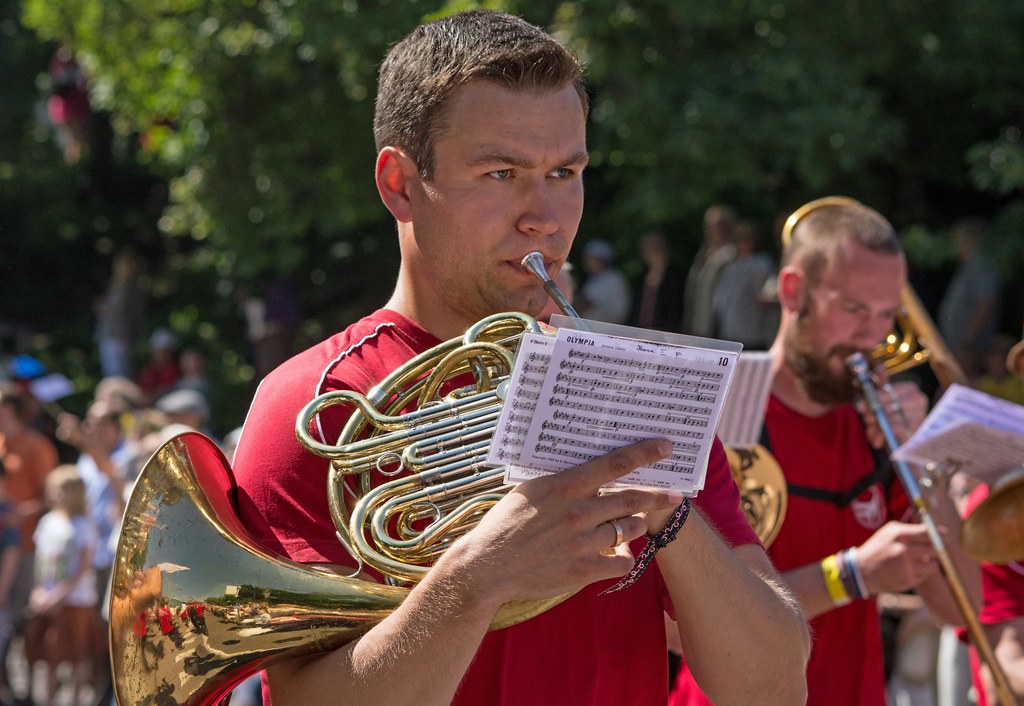
Most french horn players should play on a double horn. The exception to this is possibly children and beginners, who may benefit from using a lighter or smaller single F horn or from avoiding the confusion of adding the extra set of Bb side fingerings.
Without a double horn, the higher registers of the horn can be extremely challenging, especially for beginner and intermediate horn students. Using a double horn makes these more accessible while still offering the option to use the rich tone of the low F side of the horn.
What is a Compensating Double Horn?
One option that falls halfway between a single and double horn is known as a compensating double horn. Rather than being a true double horn (which has two sets of valve slides, one for each side of the horn), a compensating horn uses the F side by adding an extra length of tubing, as well as small additional lengths which ‘compensate’ for the intonation problems that would normally be caused by using the same set of slides for each side of the instrument.
As such, these horns might even be considered Bb horns with an ‘F extension’ rather than a double horn as such, which has two independent lengths of tubing.
Compensating double horns achieves two of the goals of double horns – to cover all the notes in the range of the horn and offer the accuracy and ease of playing benefits offered by the Bb side. However, they compromise by not offering the true rich sound of the F side, and as such, might not blend easily in an orchestral setting alongside other players using full double horns.
These instruments are generally best for relatively new players who want to get used to the feeling and fingerings of a double horn without shelling out the cash for one.
Some professional models of compensating double horns exist but are generally used either by principal players, who have less requirement to blend and use the Bb side of the horn more anyway or by players for whom it’s beneficial to have a light, easily transported instrument, perhaps in a chamber ensemble or for teaching purposes.
Pros
- Lighter than a full double
- Covers the whole range with the same fingerings as a double horn
- Normally cheaper than an equivalent level full double
Cons
- Generally less good intonation than a full double
- No rich low F side
- May not blend as well in a section of double horns
Geyer Wrap/Kruspe Wrap
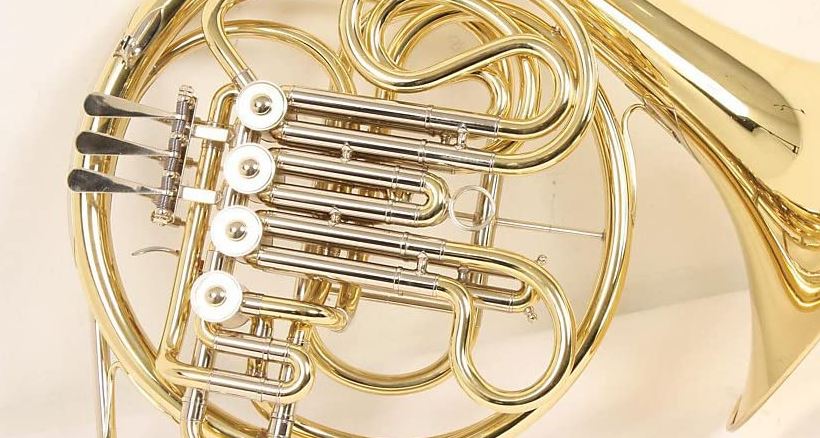
Remember Kruspe from the history bit earlier? Well, his wrap (design of tubing) is still in use today as one of the main horn designs. In the USA, most horn designs fall into two categories; Geyer and Kruspe wrap.
Each of these has its own pitfalls and benefits. For example, Geyer wrap horns have traditionally been more popular towards the East coast of the United States. In contrast, Kruspe horns are more popular out west, particularly in LA, which is famous for the ‘Hollywood horn sound.’
Geyer horns are recognizable as they have all of the valves aligned in one straight line. These horns are renowned for being free-blowing, versatile instruments. Kruspe wrap horns are traditionally more of a west coast thing in the US. In the Kruspe type of wrap, the three main valves are in a straight line, but the Bb/F ‘change valve’ is offset.
The Hollywood Horn sound traditionally comes from sections of players playing the legendary Conn 8D, the most famous example of this instrument. While generally larger bore than Geyer horns and therefore requiring more air, these horns are famous for making a large powerful sound.
Other Wraps
Around the world, other wraps of horn tend to be more popular. In Europe, especially Germany, the most popular double horn is by far the legendary Alexander 103. Paxman instruments, manufactured in the UK, are a popular alternative in some other European countries, such as France, the UK, and Italy.
Later in this article, we’ll look at two of these horns in the ‘professional horns’ category; the Alexander 103 and the Paxman 20. These are the most popular models of European double horns, though there are many other fantastic models from these brands and others!
How to Choose a Horn
Now that you know all about different types of double horns, let’s think about how to actually choose one!
In my opinion, there are a few criteria you should think about when choosing a double horn. These are;
- Intonation
- Sound
- Look/Feel
- Who you are!
Let’s take a look at each of these in detail.
Intonation
Intonation is a crucial aspect of any instrument. After all, there’s no point in having something that looks like a dream but has certain notes that honk out of tune. On a double horn, intonation is a little trickier than on a single horn, as you have more slides to deal with. This can be a little confusing also, and you’ll need to understand how to tune them to test out a horn fairly!
The first thing you should do is identify which slide is which. Following the tube round from the mouthpiece, the first tuning slide you come to will be the main tuning slide of the instrument. You’ll also have a Bb tuning slide (attached to the lower half of the valves) and an F tuning slide (attached to the upper part).
You will also have two tuning slides for each valve. The upper one corresponds with the F side valves, while the lower one corresponds to the Bb side.
Before you test a horn out by playing some of your favorite tunes, it makes sense to adjust the slides to be in tune and give it a fair chance. To do this, first, tune an open ‘C’ on the F side with a mechanical tuner before matching your Bb side C to this. You can then tune the valves, beginning with the second valve, which should make a good semitone, the first should make a tone, and the third, which I like to tune as part of the 1+3 combination.
Intonation is always something of a compromise, so there are many different ways to tune your horn! Any method like this will get you close enough to give the horn a fair chance. If you’re unsure about the intonation of the horn, it’s always a great idea to ask a teacher or friend who plays to have a go and see what they think.
Sound

After intonation, another key aspect of the horn is what kind of tone it makes. While most of the nature of the sound quality comes down to the skills of the player rather than the make of the instrument, certain horns can help you make certain sounds much more easily!
The different wraps of horn that we discussed earlier are key here, but there’s a lot more that comes into play. Generally, larger bore horns will make darker sounds, while smaller bore horns are brighter but considered more responsive. It’s a bit more complex than this, though, as often the flare of horns is very different.
The Alex 103, for example, which is generally considered a medium-size horn, actually has a wider bore through the majority of the instrument than some others that are marketed as a large or extra-large bore, although those instruments will have a larger bell.
Bell size makes a difference not only to the sound of the horn but to how to play it! Larger bells generally require a better understanding of the right-hand technique on the horn, which can be useful in any horn player’s arsenal. This goes a bit beyond the scope of this article, but check out Colin Dorman’s page all about the right-hand position here. https://colindorman.com/french-horn-right-hand/
The material the horn is made from also makes a difference. Heavier alloys, such as gold brass or nickel, have a reputation for making darker sounds than yellow brass. Some players believe that the finish of the instrument (lacquered, plated, or unlacquered) can make a difference, although the efficiency of modern lacquering processes means that the effect of this is now much less than on older instruments.
Look and Feel of the Horn
‘Look and feel’ is a deliberately slightly vague category! This means how the horn feels to play, as well as how it looks. There are some practical considerations to take into account, too, such as whether the horn has a detachable bell and what type of valves it has.
Players like to talk about horns as ‘free blowing’ or ‘resistant.’ This generally means how much air you have to use to play it. A resistant horn can be great for high notes and playing quietly but maybe a little trickier to play loudly with a good sound. More free-blowing instruments might take a lot of air and have a less secure high register.
Most models of horn have the option of a detachable bell. These horns have the option to remove the bell of the instrument by unscrewing it, which makes traveling much easier by changing the normally unwieldy shape of the horn and making it fit into backpack size!
This also helps airline travel, as although a fixed bell horn is normally larger than airline regulations allow it to be carried as hand luggage, detachable bell cases are normally designed with this in mind to be able to fit.
The type of valve that the horn has can make a difference in its performance. Horn makers generally offer the option of strung or mechanical valves. In general, mechanical valves are more reliable (as string can snap when it gets older), but they also require more regular lubrication to avoid becoming slow and clunky as they have more moving parts.
However, if you can learn to repair the string valves yourself (just in case of very rare emergencies), these valves are a great option as they are normally lighter and more responsive.
Something you can do to test the condition of the horn is to check what’s known as valve compression. This means how much air escapes from the valves. Over time, valves become slightly worn, which means that very small patches of air can escape through what should be a tight seal. To test this, try pulling out a valve slide without depressing the corresponding valve. The louder the ‘pop’ you hear, the tighter the compression of the valves.
Finally, you’ll need to think a bit about who you are… The horns that people use professionally vary quite a bit by country, and in some cases, even by a teacher. If you’re considering higher education on the horn, get in touch with the teacher you’re likely to be studying with and check out their recommendations.
In some countries, such as Germany, auditioning on an unusual horn might be seen as a bit naive (although Americans have won jobs in Germany on American horns in the past). If you’re an amateur player just having fun, don’t worry too much about these things — just find something you feel great playing, and enjoy!
Budget horns – The Best Way to Get a Horn on a Budget
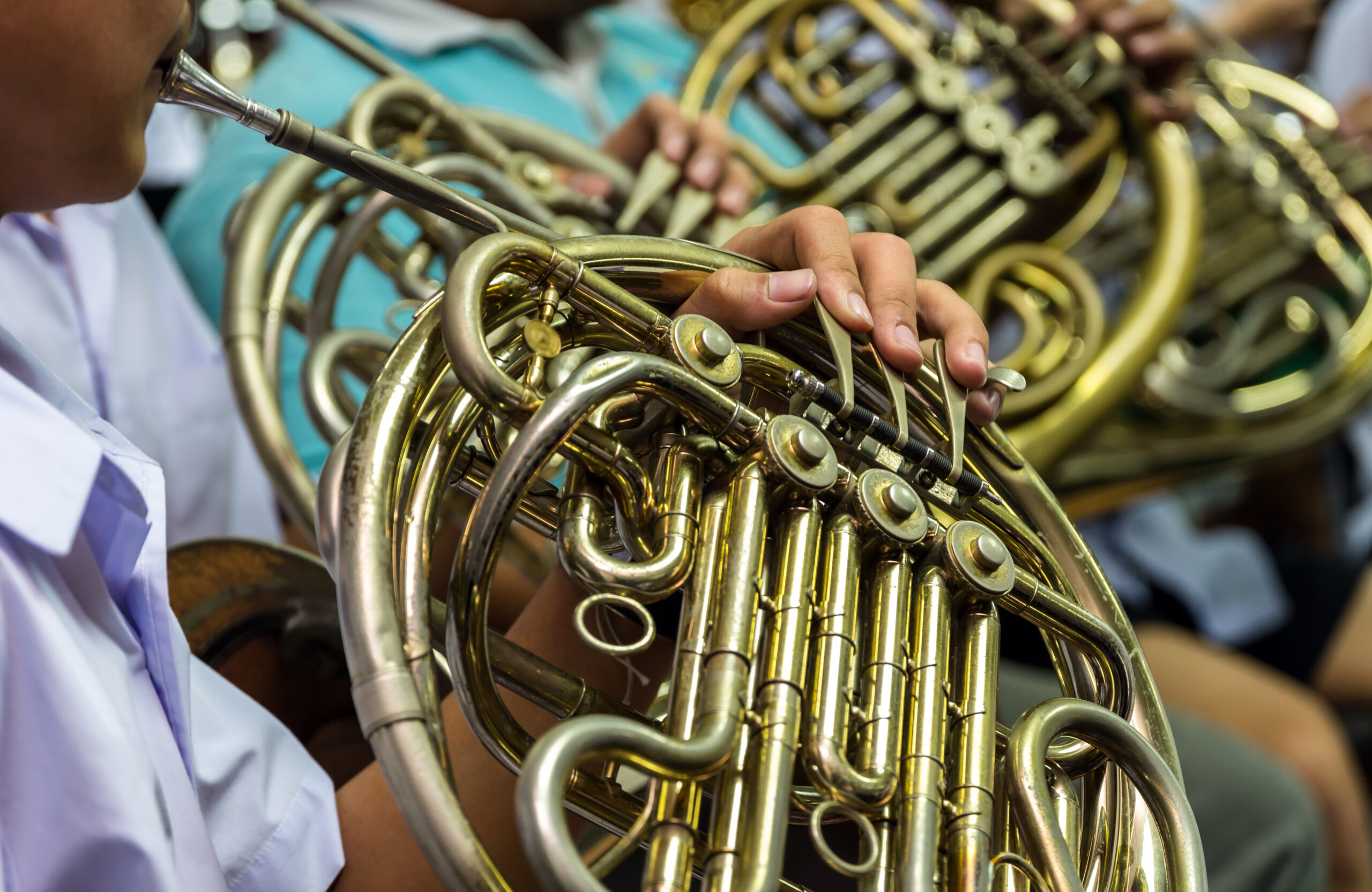
If you’re working on a budget, there are better ways to buy a horn than buying one brand new from the maker. Most horn-specific shops (such as Houghton Horns or Pope Horns in the US) stock many second-hand horns, which are normally significantly reduced compared to new horns, even when they’re the same quality.
In fact, most professional horn players I know purchase their horns second-hand. This saves a fair bit of money for what’s normally just a slight cosmetic difference.
You can often find these in horn shops or on internet sites (though please be careful on e-commerce sites, as there are scams and stolen instruments out there). Never buy a horn without trying it other than from a reputable dealer, and always make sure you follow a website’s buying guides to be safe.
Best Makes of Double Horn
And so onto some of the best makes of double horn! There are a lot of fantastic horns out there, so please consider this by no means an exhaustive list. If you have a teacher, they should be a great source of information about which instruments are most popular in your area and will suit your playing most. They may also be willing to go to the shop to try out horns with you, which would be tremendously useful!
Beginner/Intermediate Double Horns
If you’re thinking about buying a double horn, great! You have an exciting time ahead of you. There are, however, some pitfalls to be aware of. Avoid the cheaper instruments available on e-commerce sites: these are often inferior quality copies of bigger brands’ models.
While they might seem great bargains at first, you might find serious issues with the durability or intonation of these. If you’re after a budget value, it’s always better to try to find a secondhand horn from a reputable brand than a budget new one from these makers.
Some student horns are of great quality and will last you a fair amount of time. These horns are built with the consideration of beginners, so they are generally easier to play and more durable than more expensive models.
At the next level up, you’ll find intermediate models of the horn. These often have many of the manufacturing features and playing characteristics of better horns, just at a more affordable price. There’s quite a bit of crossover in quality between ‘student’ and ‘intermediate’ horns, so I’ve included them all in one category.
Jupiter JHR 1100 ‘Performance Series’
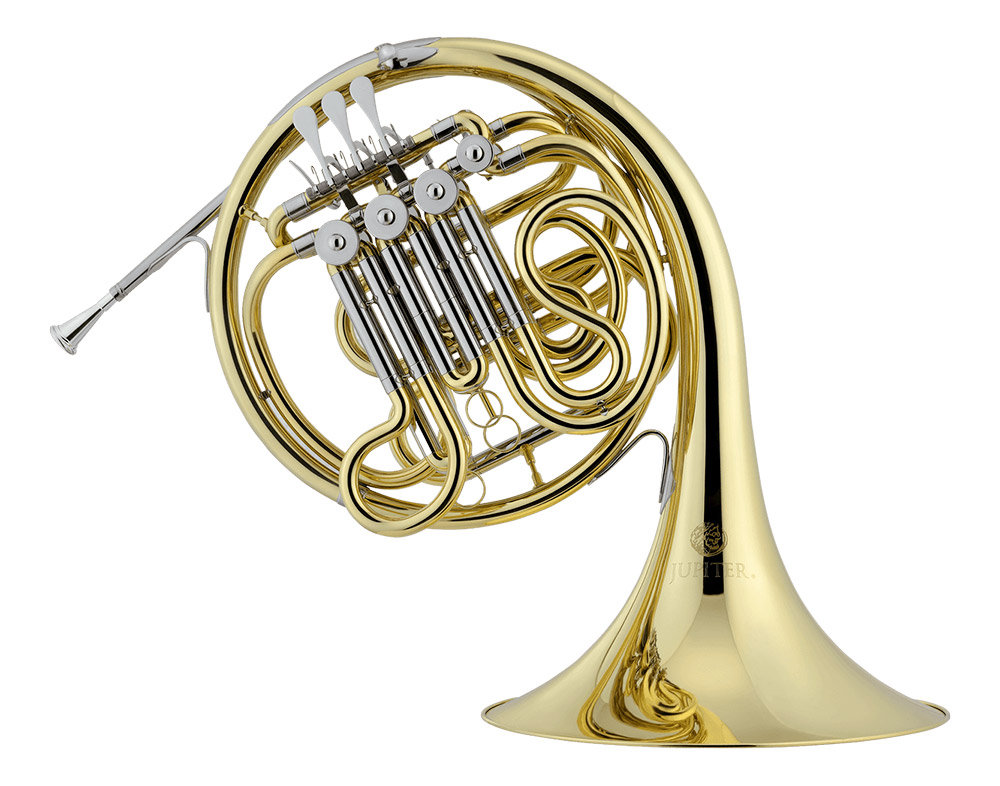
This is the first horn on my list. As for a relatively low price, you can get a great beginner horn that can last you up until college standards. This is a beginner Geyer wrap horn, so it is free blowing. It comes with mechanical linkage valves as default, with the option of a detachable bell if you wish!
This horn costs around $3000 brand new.
- Geyer wrap
- Rose brass leadpipe
- Mechanical Valve Linkage
- Optional detachable bell36
John Packer JP164
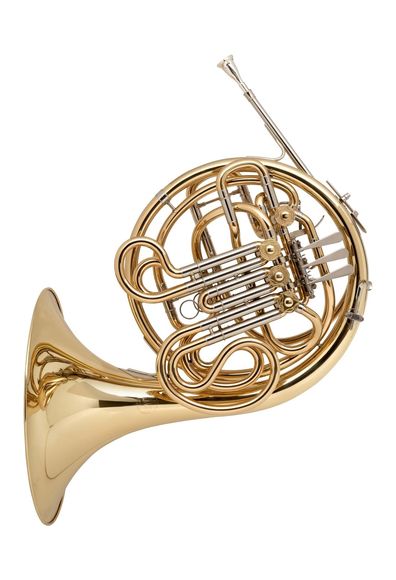
If you prefer a Kruspe-style horn, the JP164 might be the beginner horn for you. This yellow brass horn has the bonus of adjustable handgrips, which are very helpful for young horn students.
This horn costs around $3300 brand new.
- Kruspe Wrap
- Yellow Brass
- Mechanical Valve Linkage
Conn 6D
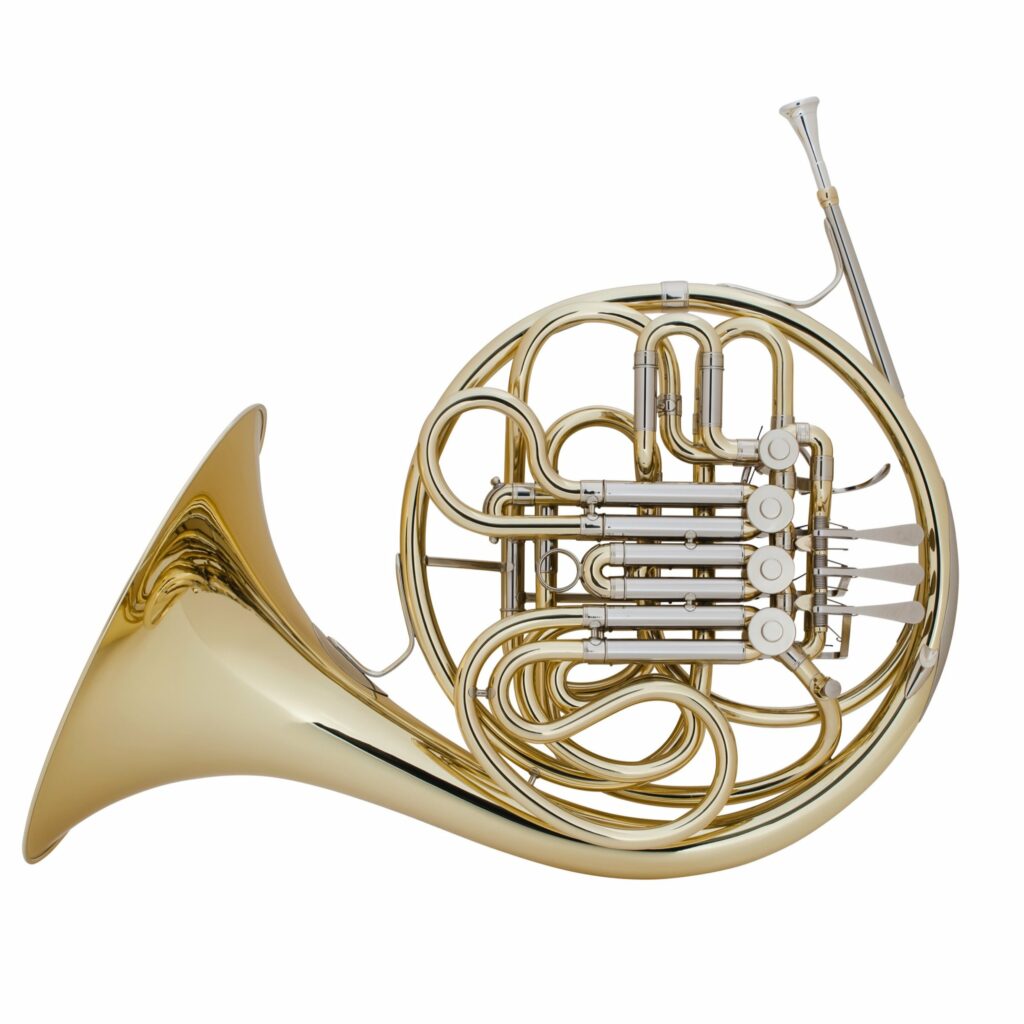
The Conn 6D is a slight variation on the conventional Kruspe wrap; this horn is ergonomically designed to be a little better for those with smaller hands. That said, this horn is a great intermediate standard horn in its own right. It comes with plenty of options, such as a silver plate finish or a detachable bell.
This horn costs around $3500 new.
- Kruspe Wrap
- Yellow Brass (with silver plate finish optional)
- Optional Detachable Bell
Holton 179
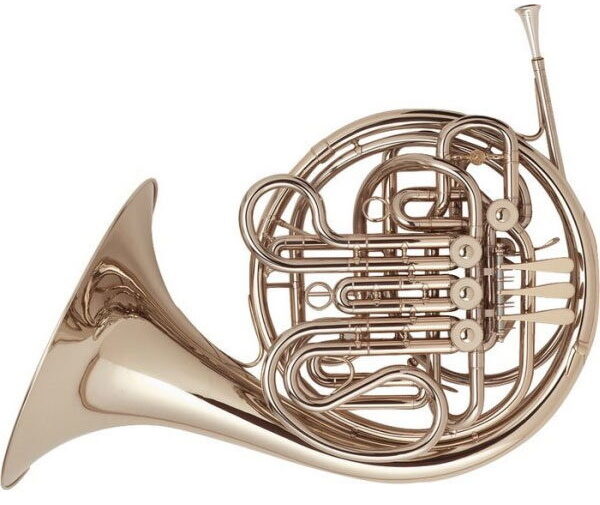
A step up from the Jupiter and John Packer horns, the Holton 179 is a horn that’s suited for all levels of horn playing. This model of the horn has been around since the late 1960s, at which point it was something of a flagship model. Today, this horn is tremendously popular with high school bands and orchestras, as it’s easy to play but also has the potential for keen students to make a great sound on it.
This is another Kruspe horn and is renowned for making the dark Kruspe sound. It’s available either in a brass model (179) or solid nickel (279), which makes an even bigger sound (though the weight of this is likely unsuitable for young students).
This horn costs around $4500 new.
- Kruspe Wrap
- Brass or Nickel options
- String Valves
Yamaha 567
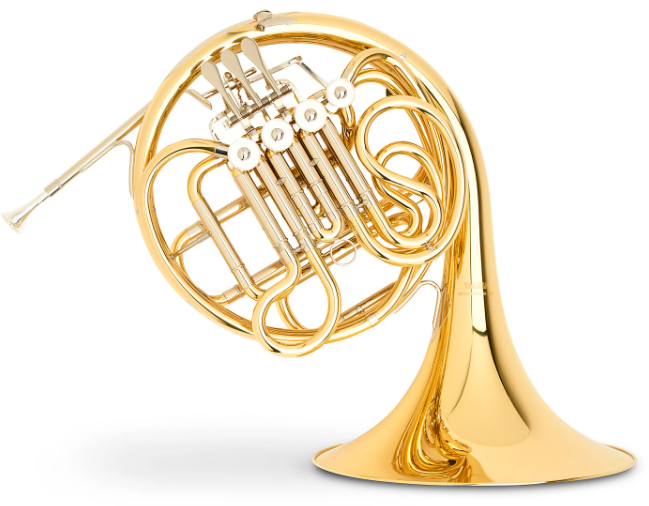
The Yamaha 567 is a great intermediate model horn. This is a Geyer wrap horn and comes in yellow brass with string linkage valves as default. I’d consider this horn a Geyer wrap equivalent to the Holton 179 – as it’s suitable for almost all levels of playing. This has the option to have a detachable bell and would be a great horn for a student who prefers the slightly brighter Geyer sound to that of Kruspe-style horns.
This horn costs around $4200 new.
- Geyer Wrap
- Yellow Brass
- String Valve Linkage
- Optional Detachable Bell
Professional Double Horns
Finally, up to the professional horns! These are generally the brand’s flagship models and, while more expensive than other horns, can be a huge step up. These instruments aren’t always the easiest to play, so you’ll need to carefully go through every item on my ‘choosing a horn’ criteria list to make sure you get one that suits you!
Don’t be afraid to try many professional-level horns before choosing one. There’s a huge range of varieties of models of horn out there. As they are often handmade, these horns tend to vary wildly, sometimes even between horns of the same brand and model! Your dream horn will play exactly how you want and help you make your ideal sound, so settle for nothing less.
For this list, I’ve included four absolute classic models of horn; the Conn 8D (Kruspe Wrap), Yamaha 871 (Geyer Wrap), Alexander 103, and Paxman 20.
Conn 8D

The Conn 8D is a legendary workhorse, particularly famous for its use in the West Coast of the USA and Hollywood studios. This large Kruspe wrap horn makes a big dark sound, especially made from its traditional nickel. Many professionals across America use this horn, and it’s also a popular choice for some low-horn players in Europe.
Today, the V8D copies the vintage style ‘Elkhart’ 8Ds, which remain a popular second-hand choice of horn due to their extra-large size and sound. I’d recommend trying both this and the normal 8D to see which you prefer! These horns come in a range of styles, such as lacquer finish or silver finish, and have the option of a detachable bell.
A Conn 8D can be bought for $5000 – $7000 brand new, depending on where you buy it, the style, and the options. With these horns a very popular choice in the US, I’d thoroughly recommend finding a second-hand one, which often plays fantastically and is even sometimes more sought after than the brand new models.
- Kruspe Wrap
- Large bore/bell size
- Nickel
- Mechanical Change Valve
- Optional Detachable Bell
Yamaha 871

The Yamaha 871 is the flagship model of the Yamaha brand. This is a free-blowing conventional Geyer wrap horn that might be considered medium size. This horn comes in a choice of yellow brass or gold brass, with the former renowned for a brighter sound and the latter a little warmer (though also more expensive). These metals also have a slightly different aesthetic appearance if that’s important to you!
A Yamaha 871 costs around $10,000, brand new.
- Geyer Wrap
- Medium Size
- String Valves
- Yellow or Gold Brass
- Optional Detachable Bell
Alexander 103
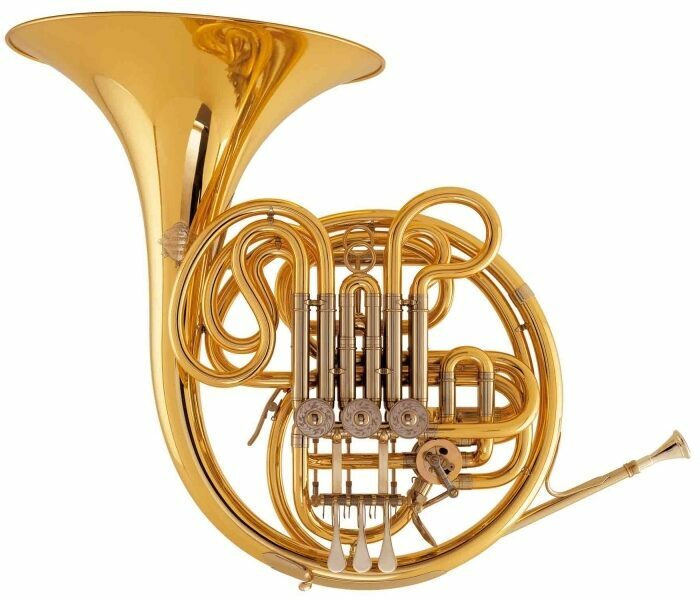
The Alexander 103 (or ‘Alex,’ as it’s often referred to) is by far the most popular model of horn in Europe. This is particularly true in Germany, where almost every professional plays on one (or at least has one as a backup). The horn players of the Berlin Philharmonic are famous for playing these instruments.
This horn is sometimes considered small, but the truth is that it’s a unique wrap with its own characteristics. While the bell of the horn is small/medium, much of the bore is on the larger side. The Alex 103 is known for its bright, exciting symphonic sound.
As these horns are handmade, they are known to vary a lot in sound and playing characteristics. If you’d like to buy one, it’s recommended that you try quite a few before finally choosing!
These horns cost around $10,000 new, depending on the options chosen.
- Unique Alexander 103 wrap
- Gold Brass/Yellow Brass options
- Mechanical/string valve options
- Detachable bell option
Paxman 20

Paxman horns are made in London and are particularly popular in the U.K, France, and Italy. The Paxman 20 is the flagship model of the brand. Like the Alexander 103, the Paxman 20 has its own unique design patented by Richard Merryweather, in which both the Bb and F sides flow in the same direction (in contrast with most horns).
These horns come in a lot of options, with bell sizes available from medium to large, yellow or gold brass, and mechanical or string valve linkages. The most popular choice is the yellow brass 20M (medium), though don’t let that stop you from trying all the options!
This horn costs around $11,000 brand new, depending on the options chosen.
- Unique Paxman wrap
- Medium, Europa, and Large bell sizes
- Yellow or Gold Brass
- Mechanical/string valve options
- Detachable bell option
FAQs
Answer: Generally, double horns are better instruments than single horns, as they have the option of either the F side or B flat side. There are, however, some exceptions. The horn players of the Vienna Philharmonic play single F Vienna horns (which have a different valve design) almost exclusively, which gives them their world-famous sound.
Some high players and soloists sometimes choose to use single horns, as they are light and versatile, but also as these players often have to play much less in the low register. For everyday playing, the double horn is a more versatile instrument as it can do everything well.
Answer: There are a few types of french horn other than the triple horn. I’ve already mentioned student single F horns, the single F Vienna horn, and compensating double horns. Some players, especially principal hornists taking on high repertoire, like to use descant horns. These smaller horns are often the Bb side of the horn coupled with an F side that’s pitched an octave above the usual F side.
Descant horns are super responsive accurate horns, generally requiring less air than a full double, but generally have a brighter sound less suitable for the general symphonic repertoire. It’s hard to make the symphonic double horn sound on one of these instruments, so for most repertoire, pro hornists prefer to use a double horn, reserving these for baroque repertoire and high Haydn symphonies!
Some players choose to combine all three pitches (Low F, Bb, and high F or Eb) into one horn, which is known as a triple horn. I’ll cover everything you need to know about these in another article for this website!
Particularly in the US, front-facing french horns are popular in marching bands, as these are much easier to play on the move than traditional french horns!


